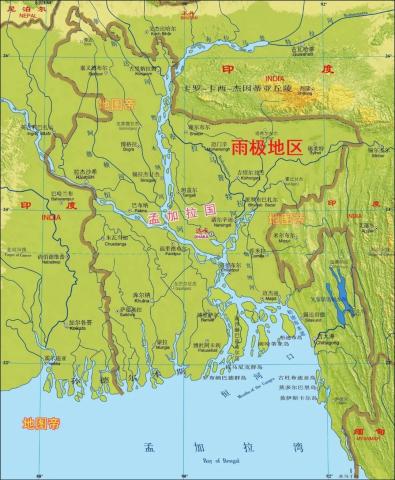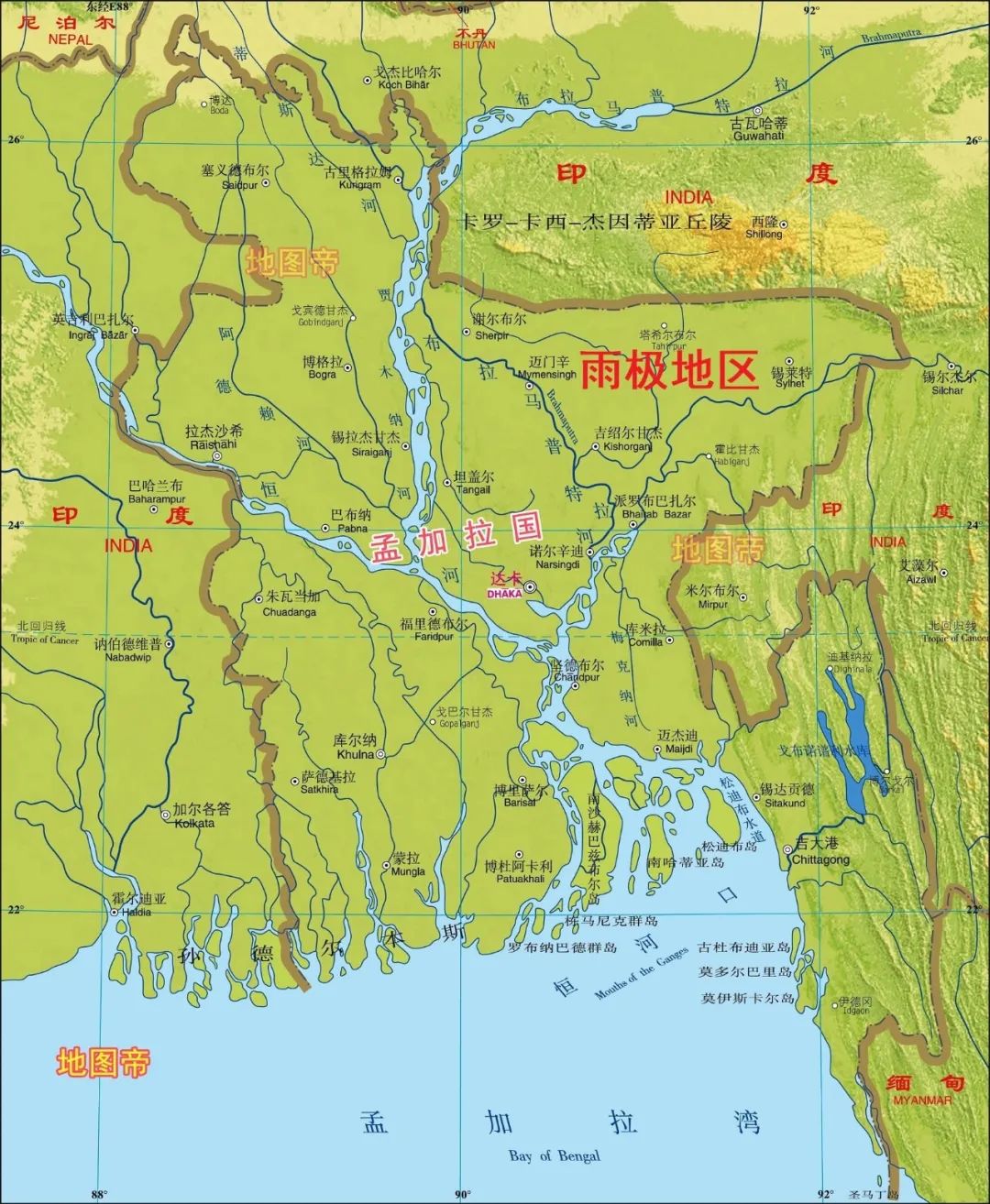
The People's Republic of Bangladesh (Bengali: গণপ্রজাতন্ত্রী বাংল, English: People's Republic of Bangladesh), referred to as Bangladesh, is a South Asian country located north of the Bay of Bengal. A small part of the southeastern mountainous area is adjacent to Myanmar, and it is adjacent to India on three sides: east, west and north. , with a total area of 147,570 square kilometers. Bangladesh is located in the northeastern part of the South Asian subcontinent on the delta plain of the lower reaches of the Ganges, Jamuna and Meghna rivers. The delta has low and flat terrain, dense river network, and developed river transportation. The southeast and northeast are hilly areas, the plains account for 85% of the country's land area, and the water surface accounts for about one-tenth of the country's land. Every rainy season, rivers and rivers rise, and large areas of land are submerged underwater, presenting the scenery of a water country. Most parts of Bangladesh have a subtropical monsoon climate, which is hot, humid and rainy. The whole year is divided into winter (November to February), summer (March to June) and rainy season (July to October). The average annual temperature is 26.5℃. Winter is the most pleasant season of the year. As of December 2019, the population was approximately 160 million. Bengalis account for 98%, and there are more than 20 ethnic minorities. Bengali is the national language and English is the official language. Islam is the state religion, and Muslims account for 88% of the total population.

Bengal was first inhabited by Asians and Australians. It became the territory of the Mauryan Dynasty in the 4th century BC, and Buddhism began to be introduced to Bengal. In the 4th century AD, Bengal became the territory of the Gupta dynasty. It became the territory of the Delhi Sultanate at the end of the 12th century. In the 13th century, he converted to Islam under foreign influence and established the Sultanate of Bengal in 1338, with Dhaka as its capital. It was annexed by the Mughal Empire in 1576. Later, European colonists (including Portugal, the Netherlands, etc.) visited one after another. In 1757, it became a province of British India. After the partition of India and Pakistan in 1947, it became part of Pakistan and was called for East Pakistan. Independence was achieved on March 26, 1971, and the People's Republic of Bangladesh was formally established in January 1972.
Bangladesh is one of the least developed countries in the world with a weak economic foundation. The national economy mainly relies on agriculture. Its agricultural products mainly include tea, rice, wheat, sugar cane, jute and their products. Bangladesh is the second largest country in the world after India. A large jute producer (accounting for 1/3 of the world's production), it is also the world's largest jute exporter (accounting for 95% of the world's total exports). Jute export revenue once accounted for 80% of its total export revenue. Mineral deposits include natural gas, coal, titanium, zirconium, etc. The industry is mainly based on the production of raw materials and primary products, including cement, fertilizers, paper, and food processing. Heavy industry is weak and manufacturing is weak. Undeveloped. Export jute and its products, leather, tea, aquatic products, clothing, etc. Imports of production materials, textiles, petroleum and petroleum-related products, basic metals such as steel, edible oil, cotton, etc.
Bangladesh is the most densely populated country in the world and one of the poorest countries in the world. It has the largest delta in the world, the rainiest area in the world and the most polluted city in the world. These all constitute Bangladesh’s tourism industry. theme, in addition, there are a large number of Islamic relics and royal palace ruins here, many of which are listed as world heritage sites. The friendly people here and their highly gathered lifestyle also constitute a unique scene, leaving a deep impression on tourists. impression. Chinese tourists visiting Bangladesh can apply for visa on arrival at the airport.
Dhaka is located on the north bank of the Buriganga River in the Ganges Delta. It is the capital and largest city of Bangladesh, with a population of more than 15 million. The urban area is located on alluvial terraces 6-7.5 meters above sea level, and the suburbs are fertile delta plains. It is the country's largest industrial center and the country's largest commodity distribution center. It is a national railway, highway and inland shipping hub. Dhaka has a long history. It was built in the 15th century and fell to the British in 1765. It was the capital of East Bengal and Assam from 1905 to 1912. It became a commercial and academic center in the early 20th century and became the capital of East Pakistan in 1947. The capital of Bangladesh in 1971.
There are many places of interest in Dhaka, from the Muslim Mughal dynasty to the colonial powers of Portugal and the Dutch, from the emperors of the Hindu landlord era to the British East India Company who likes to plunder people's wealth everywhere in Southeast Asia. They all left different styles of architecture in Dhaka. After the founding of the People's Republic of China, the government also built many memorial buildings, which constitute the theme of Dhaka tourism. In addition, Dhaka is one of the cities with the highest population density in the world. Watching the crowded flow of people on the street has become another theme for tourists. Here is The city with a record-breaking number of tricycles in the world has 2 million tricycles in the city.

I got off the plane in the middle of the night and after applying for my visa on arrival, I rested in the airport lounge for more than two hours before dawn. Not far from the terminal is the train station, where there is a train from northern Bangladesh to Dhaka Railway Station almost every hour. The most convenient way to get from the airport to the city is to take the train. No one checked tickets at the station or on the train, and I couldn't find a place to buy tickets. I arrived at the Dhaka train station inexplicably.
Dhaka Airport

Airport train station

On the train

Dhaka Railway Station


My first impression of Dhaka was that there were too many people. Almost every street was packed with people.

The second impression is that the city is gray and the visibility is very poor. Although it is a sunny day, the city is shrouded in smog. Compared with Brunei, the contrast is too big.

Human-powered tricycles are the mainstay of urban transportation

There are also demonstrations


My first stop was Baitul Mukarram Masjid, the national mosque of Bangladesh, built in 1968 and the 10th largest mosque in the world. This is a modern reinforced concrete building.




Then I followed the map to find the National Martyrs Monument, but it turned out that the map was wrongly marked and led me to the riverside pier. There is a bridge across the Buriganga River, which is a good place for viewing.





There are people and cars everywhere

There is a wholesale food market under the bridge.



It's so crowded here that after the cars are unloaded, it's almost all the loaders who carry the goods on their heads.





Not far from the wholesale market, you can see a pink mansion. This is the Ahsan Manzil Pink Palace. It was a private residence renovated in 1872 by a landowner, Nawab Abdul Ghani, on the basis of a warehouse left by the French. , it was later damaged by a tornado and was rebuilt by the government in 1980. Now converted into a museum, this is a two-story building with 23 rooms, showing the life of the rich at that time.









Bangladeshis, like Indians, really like to take photos with foreigners. In just one hour, I was dragged to take photos by several waves of people.


I continued walking around the streets in the afternoon and once again saw the messy streets, crowded people and tricycle traffic. During the election period, the joints were hung with leaflets for the electors.





Dhaka University is the oldest and largest university in Bangladesh. It was founded in 1921 and was once known as the "Oxford of the East". There are currently more than 30,000 students, with a total of 47 majors and 8 research institutes. Accounting Week is taking place.



There is also a Confucius Institute here

Just in time for Sunday, the bus takes students back to school

Finally, I came to the National Parliament House, the parliament building. This building was designed by the famous American architect Louis Kahn. Its appearance is composed of simple geometric lines. Its appearance is clean and steady, symbolizing justice and incorruptibility.


There is an event countdown display, but I can’t understand its meaning.

Two more beauties wanted to take a photo with me, which gave me an "amorous encounter".

That night, I took a long-distance bus to the seaside city of Cox's Bazar. I had to wait for two hours for the bus. I took out my mobile phone that had been damaged by water in the Philippines to repair it. I only had to pay the equivalent of 30 yuan for the repair. It seems that in the future You can take your mobile phone repair abroad.
Car route map (400 kilometers)

